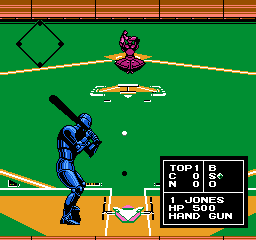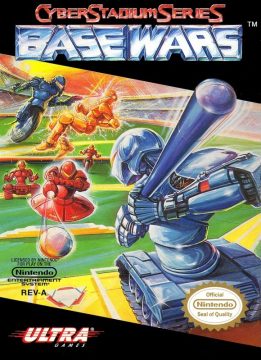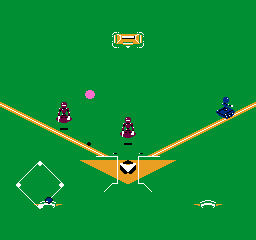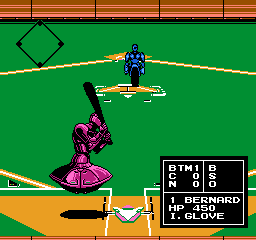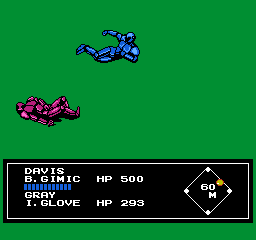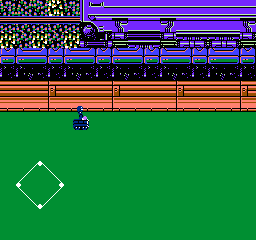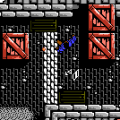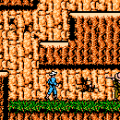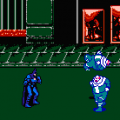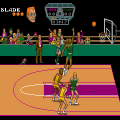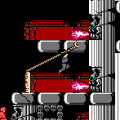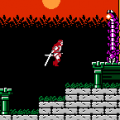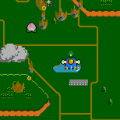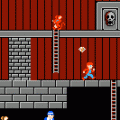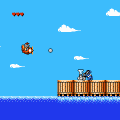Sports titles on the Nintendo Entertainment System were often interesting as well as they were frequent. Being that sports have been around far longer than virtual reality, it would only be natural that two mediums for games would collide and become an entire genre for any given console. Even in the early days of the Atari, lots of games were ostensibly to produce an experience similar to real-life sports, though the technology often did not do justice to any given sport and developers often just settled for something fun and simple if not realistic. By the time of the NES, there was enough power to make virtual sports seem realistic, and even if they still couldn’t come close to replicating the experience of watching an actual game, they made enough compromises so the games were enjoyable while resembling their base sport as closely as possible. Two such classics in this vein were Nintendo’s famous pugilist simulator Punch-Out!!, and the almighty Tecmo Super Bowl which is still considered to be one of the greatest translations of American football into cartridge form. Then we come to baseball, which is one of the most common sports found on the NES due to Japan adoring the sport as much as North America. Jaleco’s Bases Loaded series, SNK’s Baseball Stars, and the massive amount of Family Stadium games from Namco (to which Tengen’s RBI Baseball belongs) attest to Japanese developers’ admiration of baseball.
Revered game company Konami had built a reputation for high quality sports games, such as Double Dribble for basketball, Blades of Steel for hockey, and Track and Field for Olympic events. For baseball, there was Exciting Baseball (under the same exciting sports series as Double Dribble, known in Japan as Exciting Basket), but this never came over to Western shores. However, a bit later in Konami’s NES history came a particularly outlandish game during a time where developers would do crazy things to sports games for who knows why. Perhaps they felt normal sports were too boring, or that they had the means to make sports more interesting by introducing unrealistic elements that would never happen in real-life sports. Pigskin 621 A.D. was Bally Midway’s barbaric spin on football where the players could kill each other, and Nintendo’s F-Zero gave competitive racing a high-speed kick with futuristic vehicles that run on jet engines. Konami punched up the great national pastime by making all of the players robots and giving them the option to beat the crap out of each other to fight for base dominance. Thus, Base Wars was born, with the fictional premise stating that baseball managers in the 24th century are vexed at the ridiculous salary demands of their players. They opt to replace all human players with robots which have no need for money, thus giving rise to a new generation in baseball where the machines get to beat the bolts out of each other!
Base Wars was released by Ultra Games, Konami’s American subsidiary crafted for the main purpose of skirting Nintendo’s “developers can only make five games a year” bylaw. At its absolute core, it is a baseball game, of which there were many on the NES to an almost nauseating degree. However, Base Wars has a lot more to offer for those whom think baseball is blasé, not the least of which is each team’s roster being made of robots instead of humans. There are four types of robots with markedly different attributes which account for their performance. The basic cyborg has humanoid legs and is the most well rounded in power, speed, and endurance. Motorcycle bots (shortened to Mcycle) have a big wheel for their lower body and are incredibly quick, albeit hard to control when fielding and low in physical constitution. Tank robots move slowly with their treads, but they can absorb a lot of punishment. Finally, Flybots are legless but operate on anti-gravity, and they are usually balanced in stats, albeit usually slightly weaker than cyborgs. Each robot’s design often determines how well they fare on the field, at bat, on the mound, and in one other mode that will get its own examination in a bit.
There are two different modes: Open mode for a quick single-match play, and Pennant mode for a larger tournament-style arrangement. You can set the amount of innings in Open mode from one to nine, depending on how quick you want to make a head-to-head fight, and you can set anywhere from one to six teams against each other in Pennant mode. Twelve teams are available for selection including San Francisco, Minnesota, and Boston among the choice of two edit teams where you can customize the team and player’s names, their positions, whether they’re left or right handed, and what type of robot each player is. You have to hold B in order to move around the edit screen which is somewhat strange, but it’s neat to have your very own personal team, albeit unplayable in the Pennant mode. Each team has their different strengths and weaknesses, but none is technically more flagrantly powerful than the other, so you can’t just mack your way through every opponent if you’re New York. You can set a one-player match against the AI, go head-to-head with a second human player, or even set both sides to CPU and watch the machines duke it out with each other. It’s often best enjoyed with a friend, but it’s playable against the computer, albeit it tends to read your pitches and usually slug at least one homer per game.
The game itself plays out like a baseball game would be expected to with quite a few twists. At its core, it plays very fast and smooth, though as in most baseball titles, fielding can be somewhat confusing. The screen after a ball is hit is a bit more zoomed in than it should be and it’s not always clear which robot you’re controlling to catch the ball, sometimes having your intended fieldman be entirely off the screen after the ball lands. Still, despite some fielding frustration, the game otherwise plays solid and expected of the sport. If you know baseball, most of what you’d expect is familiar here: Three strikes or ball caught and you’re out, four balls and you walk to first, balls over the far end bleachers are a home run, balls into the foul zone count as a strike unless two strikes are down, etc. All the rules are there and the control is quite tight. At bat, holding up or down raises or lowers the trajectory of your swing, so be aware in case you find yourself missing several balls that seem to be clean hits.
Now there’s more to Base Wars than just how the robots look. Batting is straightforward, but pitching is a bit different than in other games. The pitcher fires the ball out of an arm-mounted cannon and can either fire it immediately for a weak slow ball or hold the pitch button to charge up and blast out a superfast ball. The ball is also incredibly controllable if you shoot a slow ball, where you can cause the ball to float way off the plate, move up or down just out of the strike zone’s range, and even spiral it around and fly in all sorts of crazy patterns to flummox the batter. However, there’s more to this game than funky pitching physics; if a runner gets tagged by a baseman on his way to a base, instead of being automatically tagged out, the runner has a chance to salvage his run by engaging in a duel against the fielder. In normal baseball, fights usually break out when incredibly frustrated players and/or coaches lose their temper, usually resulting in the banishment of those who start it and willingly participate in it. In Base Wars, fights are not only encouraged, but they’re a vital part of gameplay and the main thing that makes Base Wars stand out from the rest of the virtual baseball mold.
Each fight takes place one-on-one with view on the robots zoomed in with a side view, somewhat akin to Street Fighter; however, the robots can move up and down like Final Fight. Both robots have a lifebar which the runner must beat out of the baseman to claim its base or vice-versa for the baseman to tag out the runner. The runner’s lifebar always drains down to a certain amount depending on how close it was to the base before getting tagged; if right at the base, it only loses a few points, but if barely having left the last base, it loses much of its lifebar and stands little chance against the baseman. There is also another counter for the overall hit points a single robot can take, which they lose either by taking damage at the base or getting hit by pitches. If this bar fully drains, the robot explodes and is out of commission for the rest of the game; a team must forfeit if they lose three robots in a single game. Each robot comes with one of seven weapons: The weak Iron Glove and Hand Gun, the considerably stronger Fire Gun and Muramasa, or the incredibly powerful Laser Gun and Laser Sword which can obliterate enemies simply by holding the A button but has the caveat of draining the user’s hit points when used. Then there’s the interesting Battle Gimmick, a strange name for what is essentially a flying fist attack which ejects when you hold A and retracts when released; it is potentially the best weapon as it can knock out the opponent with skillful use without the HP drain of the laser weapons.
Each robot has a special B button attack depending on what model they are; cyborgs use jump kicks, mcycles use a flipping spin attack, tanks charge forward, and flybots float up to crush the opponent. Both attack buttons can even be held to charge up a powerful attack, though this is generally not recommended as the most effective way to win is via a quick speed slugfest. Fights usually last a few seconds and it often comes down to who attacks first and has the more appropriate weapon. While battles aren’t really complex and usually come down to attrition, they last for only a few seconds and don’t often overstay their welcome, at least not in quick rumbles on Open mode. However, for longer Pennant games, there exists a shop where you can upgrade your players’ weapons to stand a better chance against the opposition. You can also purchase upgraded units for catch (fielding speed), shoot (improved pitching), unit (base running speed), engine (rate of healing in battle), and shoulder (batting power). You can also heal up players who’ve been damaged in the previous game, though it’ll cost you if any of them were destroyed.
Base Wars offers reasonably familiar play for baseball fans with enough new elements to spice it up for those looking to play a new take on the genre. Rounding out the package are some mostly impressive graphics with incredible detail on the robots at bat and in the fight. Their sprites on the field seem a bit primitive in comparison, but at least you can tell what each robot is supposed to be and where the ball is, which glows when seen on the overhead. There are neat details here and there, like the creepy holographic shopkeeper and a pan out to a random space station with a flying ship that spells “HOMERUN” for each one slugged out of the park. On top of this is sound design par excellence for a Konami game, with the main play music being jaunty enough to capture the spirit of baseball and futuristic enough to account for the game’s atmosphere. While there’s not a lot of musical variety, what’s there is well-done, though you can turn it off on the main menu if you don’t particularly favor it.
Base Wars is thus left as the only game of its kind, at least on the gray box. Futuristic sports games have existed for a while, like Atari’s Cyberball three years prior to Base Wars (although that game is about American football), and SNK’s 2020 Super Baseball is akin in futuristic design to Base Wars, but doesn’t have the fighting element in it. Then there’s Bill Laimbeer’s Combat Basketball, which… nah, let’s not go there. The point is that few sports titles have been able to factor in a creative setting and new elements into popular real-life games in a way that effectively satisfies the game’s base rules while integrating the new rules seamlessly. Base Wars is absolutely where it’s at if you’ve got a penchant for bot-on-bot basebrawling, and no other game that involves a diamond on a green field will likely ever offer that which is seen in the first and only Cyber Stadium league.
